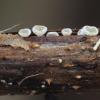
18-12-2025 21:17
Pol DebaenstThe identification took me to Byssonectria deformi

15-12-2025 07:09
 Danny Newman
Danny Newman
indet. Rutstroemiaceae sp. on unk. fallen leavesMc

19-12-2025 10:10
Patrice TANCHAUDBonjour, récolte réalisée en milieu dunaire, a

18-12-2025 17:23
 Bruno Coué
Bruno Coué
Bonjour,je serais heureux d'avoir votre avis sur c

18-12-2025 18:07
Margot en Geert VullingsThese plumes were found on rotten wood.They strong

17-12-2025 18:35
 Michel Hairaud
Michel Hairaud
Bonjour à tous/Hi to everyone I am passing along

15-12-2025 15:48
 Danny Newman
Danny Newman
Melanospora cf. lagenaria on old, rotting, fallen

15-12-2025 15:54
 Johan Boonefaes
Johan Boonefaes
Unknown anamorph found on the ground in coastal sa

15-12-2025 21:11
 Hardware Tony
Hardware Tony
Small clavate hairs, negative croziers and IKI bb
 Hello
HelloI have found this nice Lachnum on last years stem of Rubus idaeus. I firstly thought it was L. clavigerum, but it has a colour change - first yellow as seen on the photo later red-brownish. Also the spores are to big.
Sp. elipsoid-flattened elipsoid, 9-12 x 2-2,5. Asci approx. 55 x 4 µm without croziers, J+ (blue). Hairs cylindrical with warts/spines, some with crystals on the top. Paraphyses fusiform 3,5 µm broad
Cheers
Rasmus

Hello Rasmus,
in Lachnum you should first note 3 things:
- croziers (you did and say no)
- contents of living paraphyses (and hairs) - with or without a large amount of vacuolar guttules. I suggest: no
- crystals on the hairs. You do not mention then, so I think no.
L. clavigerum (as far as I have it in my mind correctly) has crystals on the hairs. I never found it on Rubus, but (as far as I remember) on Epilobium angustifolium.
The most common species on Rubus is L. virgineum - what do you think?
Best regards, Lothar

Thanks for the comments!
A lot of the hairs does in fact have crystals on the top. Also the colour change when bruised is quite distinct and not present in L. virginum as far as i know.
Best regards
Rasmus

I have a clavigerum folder for Rubus idaeus, with several samples (including HB 8585).
The spectrum of the species includes also Aruncus etc. I am not sure if there are any clear differences between the substrates, except for spore size:
9-11 x 2-2.5 on Rubus
6-9 x 1.7-2 on Epilobium/Aruncus
So perhaps two species?
Rasmus' description includes crystals. The colour change would point to VBs in the paraphyses and hairs, but for a species with crystals this is impossible. Actually, a yellowish-cream disc is not unusual in L. clavigerum.
Zotto

